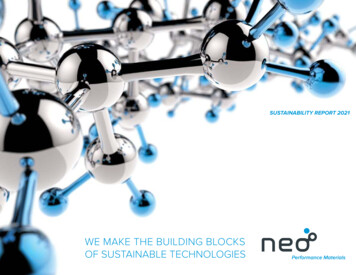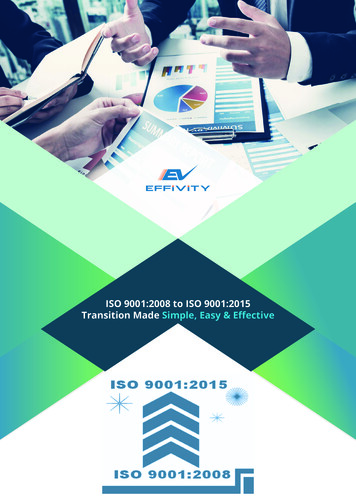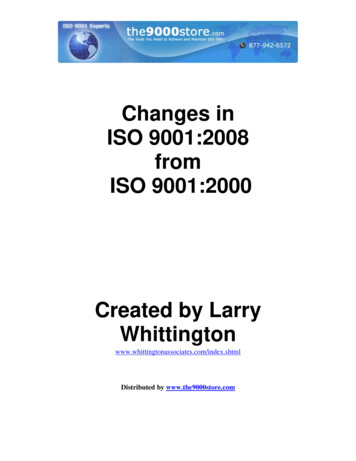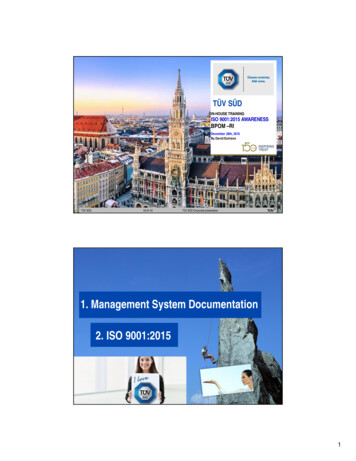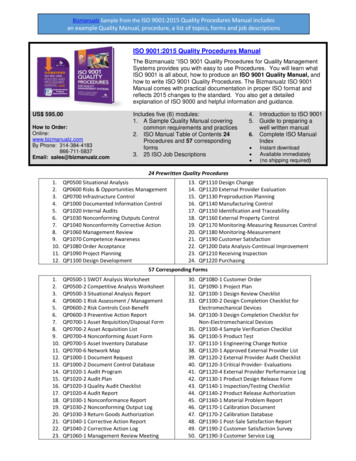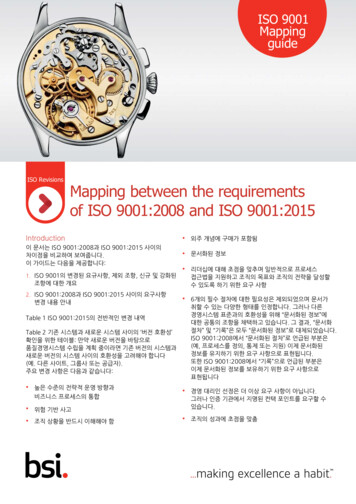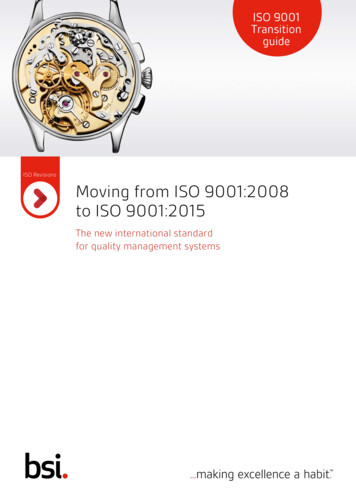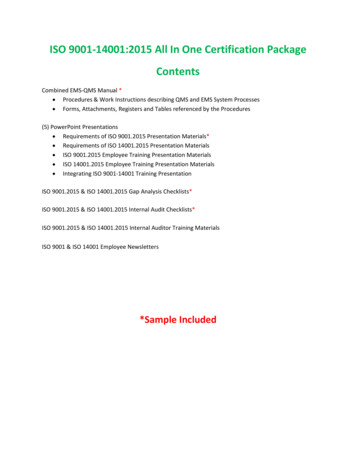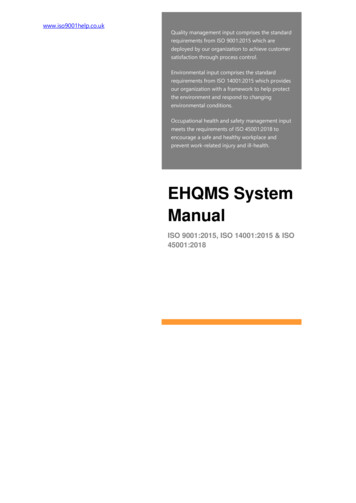
Transcription
www.iso9001help.co.ukQuality management input comprises the standardrequirements from ISO 9001:2015 which aredeployed by our organization to achieve customersatisfaction through process control.Environmental input comprises the standardrequirements from ISO 14001:2015 which providesour organization with a framework to help protectthe environment and respond to changingenvironmental conditions.Occupational health and safety management inputmeets the requirements of ISO 45001:2018 toencourage a safe and healthy workplace andprevent work-related injury and ill-health.EHQMS SystemManualISO 9001:2015, ISO 14001:2015 & ISO45001:2018
www.iso9001help.co.ukEHQMS System ManualISO 9001:2015, ISO 14001:2015 & ISO 45001:2018Table of Contents1INTRODUCTION . 52REFERENCES . 63DEFINITIONS . 64ABOUT OUR ORGANIZATION . 7ORGANIZATIONAL CONTEXT . 7RELEVANT INTERESTED PARTIES . 8MANAGEMENT SYSTEM SCOPE . 8MANAGEMENT SYSTEM PROCESSES . 95LEADERSHIP, COMMITMENT AND WORKER PARTICIPATION . 11LEADERSHIP & COMMITMENT .115.1.1General.115.1.2Customer Focus .12MANAGEMENT SYSTEM POLICIES .125.2.1Establishing our Policies .125.2.2Communicating our Policies .13ROLES, RESPONSIBILITIES AND AUTHORITIES .135.3.1Top Management .135.3.2QEHS Manager .135.3.3Quality Coordinator .145.3.4Environmental Coordinator .145.3.5Health & Safety Advisors .145.3.6Managers & Supervisors.155.3.7Workers & Contractors .15CONSULTATION & PARTICIPATION OF WORKERS AND CONTRACTORS .156PLANNING . 17GENERAL.176.1.1Risks & Opportunities .176.1.2Environmental Aspects .186.1.3Hazard Identification & Assessment .196.1.4Compliance & Legal Requirements .206.1.5Planning Action .21MANAGEMENT SYSTEM OBJECTIVES .216.2.1Integrated Objectives .216.2.2Objectives & Planning to Achieve Them .22PLANNING FOR CHANGE .237SUPPORT . 25RESOURCES .257.1.1General.25Document Ref.Page 2 of 55
www.iso9001help.co.ukEHQMS System ManualISO 9001:2015, ISO 14001:2015 & ISO 45001:20187.1.2People .257.1.3Infrastructure & Natural Resources .257.1.4Operational Environment .267.1.5Monitoring & Measurement Tools .267.1.6Organizational Knowledge .27COMPETENCE .28AWARENESS .28COMMUNICATION .297.4.1General.297.4.2Internal Communication .297.4.3External Communication.30DOCUMENTED INFORMATION .3187.5.1Management System Documents .317.5.2Creating & Updating .317.5.3Controlling Documented Information.31OPERATION . 33OPERATIONAL PLANNING & CONTROL.338.1.1Quality Operational Planning & Control .338.1.2Environmental Operational Planning & Control .338.1.3OH&S Operational Planning & Control.34DETERMINING REQUIREMENTS FOR PRODUCTS .358.2.1Customer Communication .358.2.2Determining Requirements .368.2.3Reviewing Requirements .368.2.4Changes in Requirements .36DESIGN & DEVELOPMENT .378.3.1General.378.3.2Planning.378.3.3Inputs .378.3.4Controls .388.3.5Outputs .398.3.6Changes .39CONTROL OF SUPPLIERS, EXTERNAL PROCESSES AND CONTRACTORS .398.4.1General.398.4.2Purchasing Controls.408.4.3Purchasing Information .40PRODUCTION & SERVICE PROVISION .418.5.1Control of Production & Service Provision.418.5.2Identification & Traceability .418.5.33rd Party Property .428.5.4Preservation .428.5.5Post-delivery Activities .438.5.6Control of Changes .43Document Ref.Page 3 of 55
www.iso9001help.co.ukEHQMS System ManualISO 9001:2015, ISO 14001:2015 & ISO 45001:2018RELEASE OF PRODUCTS & SERVICES .43NON-CONFORMING OUTPUTS .44EMERGENCY SITUATIONS.449PERFORMANCE EVALUATION . 46MONITORING, MEASUREMENT, ANALYSIS & EVALUATION .469.1.1General.469.1.2Customer Satisfaction .469.1.3Analysis & Evaluation .479.1.4Evaluation of Compliance.47INTERNAL AUDIT .489.2.1General.489.2.2Internal Audit Programme .48MANAGEMENT REVIEW .489.3.1General.489.3.2Inputs .499.3.3Outputs .4910IMPROVEMENT . 51GENERAL.51INCIDENT, NON-CONFORMITY & CORRECTIVE ACTION .5110.2.1Non-conformity & Corrective Action .5110.2.2Incident Investigation .52IMPROVEMENT .52APPENDICES. 54A.1QEHS PROCESS INTERACTION .54A.2ORGANIZATION CHART .55Document Ref.Page 4 of 55
EHQMS System Manualwww.iso9001help.co.ukISO 9001:2015, ISO 14001:2015 & ISO 45001:20181 IntroductionYour organization has developed and implemented an integrated Quality, Environmental and OccupationalHealth & Safety Management System, which uses ISO 9001:2015, ISO 14001:2015 and ISO 45001:2018 asframework for our organization to document and improve our operational practices in order to better satisfythe needs and expectations of our workers, customers, stakeholders and interested parties.This management system manual is used to familiarise our workers, customers, interested parties, or individualswith the controls that have been implemented and to assure them that the integrity of our management systemis maintained and is focused on meeting its intended outcomes.This manual also describes the structure and interactions of our management system, delineates authorities,inter relationships and responsibilities of personnel who operate within the boundaries of your organization’sintegrated management system (IMS), whilst providing reference to the procedures, process and activities thatcomprise it.The Figure below illustrates our methodology for the development of our integrated management system,which uses the plan, do, check and act cycle to implement the process approach that delivers managementsystem objectives, stakeholder requirements and customer satisfaction.Figure 1: Integrated Management System Process ModelInternal & External IssuesNeeds & Expectations of Interested PartiesContext of the OrganizationScope of the ommitment &WorkerParticipationDOSupport &OperationCHECKPerformanceEvaluationDocument Ref.Page 5 of 55
EHQMS System Manualwww.iso9001help.co.ukISO 9001:2015, ISO 14001:2015 & ISO 45001:2018Certification to the international standard ISO 9001:2015, ISO 14001:2015 and ISO 45001:2018 will help achievethese intended outcomes and demonstrates that the IMS is effective, provides value for our organization andits interested parties. Our management system addresses and supports our wider strategies for the design,development, manufacturing, installation and service of our products. Insert the registered address of yourorganization and/or facilities here.Insert your scope statement here. This should succinctly summarize what your business does and what yourproducts and or services are. A couple of sentences and some bullet points is all that is required, as this textwill be shown the certificate.The following table identifies any ISO 9001:2015 requirements, from Section 8.0, that are not applicable to ourorganization as well as providing a brief narrative to justify their omission from the scope of our IMS:ClauseJustification for Exclusion2 ReferencesIn addition to ISO 9001:2015, ISO 14001:2015 and ISO 45001:2018, we also make reference to other relevantnational or International standards as well as customer specifications appropriate to our context.StandardTitleDescriptionBS EN ISO 9000:2015Quality management systemsFundamentals and vocabularyBS EN ISO 9004:2000Quality management systemsGuidelines for performance improvementsBS EN ISO 19011:2011Auditing management systemsGuidelines for auditingBS EN ISO 14004:2016Environmental management systemsGuidelines for implementation3 DefinitionsThis document does not introduce any new definitions but rather relies on the following:1.Definitions typically used by our customers, stakeholders or marketplace;2.Terms typically used in standards and regulations as they relate to our products and services;3.Standard business terminology;4.Terms and vocabulary commonly used in quality and engineering, manufacturing practices.Document Ref.Page 6 of 55
EHQMS System Manualwww.iso9001help.co.ukISO 9001:2015, ISO 14001:2015 & ISO 45001:20184 About Our OrganizationOrganizational ContextYour organization is committed to defining ourFigure 2: Examples of Internal & External Influencesposition in the marketplace and understanding howrelevant factors arising from legal, political, economic,social and technological issues influence our strategicdirection and our organizational context.Types of internalinfluenceTypes of externalinfluenceDirectorsStakeholdersYour organization identifies, analyzes, monitors andreviews factors that may affect our ability to satisfyShareholdersour customers and stakeholders, as well as; factorsthat may adversely affect the stability of our processesand the integrity of the management system.UnionsWorkersTo ensure that our management system is alignedContractorswith our strategy, whilst taking account of relevantCultureinternal and external factors; we initially collate andanalyze pertinent information in order to diaCommunitypotential impact on our context and subsequentbusiness strategy.Such issues include factors that are affected by our organization or are capable of affecting our organization.Broadly, these issues are defined as:1.Internal issues – conditions related to our organizational activities, products, services, strategicdirection, culture, people, knowledge, processes and systems. Using SWOT analysis provides ourorganization with framework for reviewing and evaluating our strategies, and the position anddirection of our organization, business propositions and other ideas;2.External issues – conditions related to cultural, social, political, legal, regulatory, financial,technological, economic, competition at local, national or international levels. Using PESTLE analysisprovides our organization with framework for measuring our market and growth potential.Your organization then monitors and reviews this information to ensure that a continual understanding of eachgroup’s requirements is derived and maintained. To facilitate the understanding of our context, we regularlyconsider issues that influence our context during management review meetings using the Context & InterestedParties analysis template. The results of which are conveyed via minutes and business planning documents. Wemaintain and retain; in addition to this document, the following documented information to describe ourorganizational context and decisions relating to it:1.Context & Interested Parties analysis underpins our policies and drives our future goals;2.SWOT Analysis to help understand internal issues;3.PESTLE Analysis to help understand external issues;4.Analysis of business plans, strategies, and statutory and regulatory commitments;5.Analysis of technology and competitors;6.Economic reports from relevant business sectors;7.Technical reports from technical experts and consultants;8.Minutes of meetings (Management and design review minutes), process maps and reports, etc.Document Ref.Page 7 of 55
EHQMS System Manualwww.iso9001help.co.ukISO 9001:2015, ISO 14001:2015 & ISO 45001:2018The outputs from these activities are evident as an input to determining the scope of our management (4.3)and its processes (4.4), as well as, the consideration of risks and opportunities that may affect the IMS, and theresulting actions that we take to address them (6.1).SWOT analysis provides our organization with framework for reviewing and evaluating our strategies, and theposition and direction of our organization, business propositions and other ideas. Similarly, PESTLE analysisprovides our organization with framework for measuring our market and growth potential according to externalpolitical, economic, social, technological, legal and environmental factors.Relevant Interested PartiesYour organization identifies and classifies its interested parties, based on current information and knowledgeheld within our business. Each interested party is allocated to one or more categories and is analyzed todetermine whether any relevant needs or expectationsFigure 3: Types of Interested Partyexist; which could impact our business activities or theIMS, and which must be adopted by the organization.Using the Context & Interested Parties analysisConsumerstemplate, interested parties and their requirements areranked and scored using simple, subjective criteria tocreate a Risk Potential Number (RPN). This is calculatedCommunityRegulatorsby multiplying the perceived power score, by thepriority score, by the relevance s that maybe affected by ourorganization'sactivitiesareconverted into requirements which become inputs toIMS planning and product and/or service designs. Theoutputs from this process are typically used to informShareholdersSuppliersthe following sections and processes of the IMS:1.Management system scope - 4.3;2.Management system processes - 4.4;3.Risk and opportunities - 6.1.1;4.Environmental aspect and impacts - 6.1.2;5.OH&S hazard identification and assessment - 6.1.3;6.Compliance obligations and legal requirements - 6.1.4;7.Communication - 7.4;8.Operations - 8.0.MediaYour organization recognizes that we have a unique set of interested parties whose needs and expectationschange and develop over time, and furthermore; that only a limited set of their respective needs andexpectations are applicable to our operational purpose.Management System ScopeBased on the scope of our activities described in Section 1 - Introduction and the analysis of the issues andrequirements identified in Sections 4.1 and 4.2, your organization has established the scope of ourenvironmental management system in order the implement the objectives and policies that are relevant to ourcontext, physical and organizational boundaries, product life-cycles and any interested parties.Document Ref.Page 8 of 55
EHQMS System Manualwww.iso9001help.co.ukISO 9001:2015, ISO 14001:2015 & ISO 45001:2018Your organization is able to exert authority and differing levels of control and influence over our activities, asthey relate to our products and services, as performed at our facilities. The functional and organizationalboundaries for the different physical locations (where applicable) and the level of control and influence aresummarised below:PhysicalBoundaryFunctional BoundaryOrganizational BoundaryAuthority to Control orInfluenceOur facilities atthe followingaddress:All activities performed andmanaged by our organization whichresult in product or service outputsComplete organizationalcontrol over currentactivitiesWe have a high degree ofauthority in order to control orinfluence related processesExternal processperformed by3rd partiesUndertaking process as per ourspecificationsPurchasing andcontractual controls3rd Parties are controlled andinfluenced through contractualmechanismsIn order for our management system to be robust, all the activities, products and services undertaken by yourorganization are included with in the s
EHQMS System Manual ISO 9001:2015, ISO 14001:2015 & ISO 45001:2018 Document Ref. Page 6 of 55 Certification to the international standard ISO 9001:2015, ISO 14001:2015 and ISO 45001:2018 will help achieve these intended outcomes and demonstrates that the IMS is effective, provides value for our organization and its interested parties.

